Oil is not Well

For those that would rather watch than read, check out the video version of this article here.
I have a new “Dadism”… I’m gonna tell my kids I was alive when oil hit zero. For those that don’t know, I consider myself the king of dad jokes. Some comedians get the satisfaction from applause and laughter, I get mine from the amount and depth of eye rolls. In fact, each Father’s Day my kids usually get one of my knee slappers printed on a t-shirt.
The one thing that last week’s oils futures crash tells me is that capitalism is stronger now than ever, despite what the talking heads might tell you. First, speculation ran amuck last week as the oil futures contract didn’t just go to zero, but -37%. We will likely not know the exact reason why, or who anytime soon, but as it all washes out there will be some that profited and a few that lost their shirt. However, when the dust settles, I’m sure that it will find that the massive moves are likely related to speculators rather than the commodity itself.
Second, my phone made an impressive amount of noise with texts, calls, and emails with questions from you asking if you should buy oil. I probably received more contacts last week than I have had since the start of the pandemic. I’m not sure whether to be proud, or think I’ve created monsters of all of you.

OK, I’ll admit I’m not a commodity expert, but I do understand the futures market. Its purpose is to create a platform for those with commodities to trade physical goods for cash at some point in the future. Think about the farmer that is growing oranges. In order to reduce his risk in the price of oranges going down while his trees are growing, he will lock in the price today, for delivery of his oranges in the future. On the other side, there is a buyer of oranges, who wants to lock in that price he will pay now so he can determine what price he can get a handle on his costs moving forward. This transaction is a tiny, tiny percentage of the futures market. In the middle of these two are speculators who want to profit on price moves during that time period.
Although as I stated, we don’t know the winners or losers yet of last week’s debacle, those moves can’t be related to a simple oversupply issue. It’s not like just before the close of the futures market on Monday, someone said, “Holy moly, we can’t fit any more barrels”. I’m sure we will find a hedge fund, algo trader, or investment bank that had bet the house on the May contract of oil. These types of cataclysmic events happen every handful of years. Here’s a quick list of some of the biggest blunders according to Wikipedia, and I think you might find a new edition real soon:

Although we have technology that can substantially reduce our use and dependence of oil, particularly foreign oil, black gold is not going out of our lives anytime soon.
You may hear that oil companies are profitable at $50 oil, or $40 oil, or whatever. I believe if oil stays low for a long time, someone will figure out how to make it profitable at $25. Again, the beauty of free markets and capitalism.
A concern that some had is related to our energy producers and large oil refiners, whose stock price has been punished. Just like in any wash out, there will be some that come out on top and will be able to acquire others at distressed prices. I don’t know a better time in history for an industry to go through their generational stress test, with the government underwriting the entire economy. I don’t see a scenario where the government lets major U.S. producers to go under, making us reliant on foreign companies to deliver oil.
This scenario is not an investment thesis for me. I prefer to look for organizations that innovate and have earnings growth based on revenue not grants or one timeline items…which is why I’ve been avoiding anything energy related for some time. And I’ll happily sit on the sideline while this market figures itself out. Yes, I may look back and say, “Wow buying that was a no brainer”. However, I judge all investments as risk/return, and at least in my eyes, the risk is too high. Energy as an overall sector has slipped to be such a small percentage of the S&P 500, that being completely out of it shouldn’t affect returns that greatly, even if the energy index doubles or triples.
Back to the other 95% of the stock market index. We are now one month from the March 23rd low, and there are some that are still calling for a revisit. I don’t give that much attention, given the backstops that we have. There can always be something out there that no one has seen whacking us, but good will overcome evil, always. But don’t mistake a revisit to a market low to mean that we have to get back to the 2237 on the S&P index of March 23. Most what the call re-tests are dips that come down but settle above the previous low.
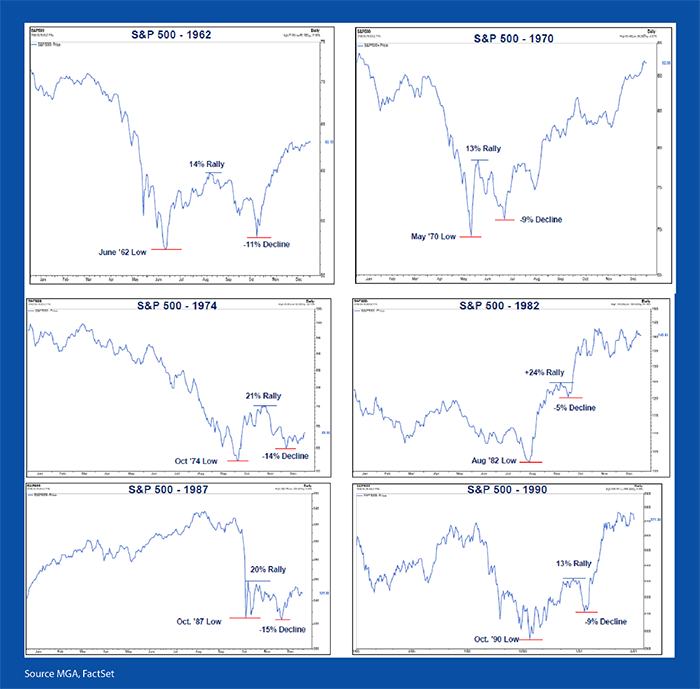
As you can see there are numerous times where a classified re-test is substantially higher than the initial low.
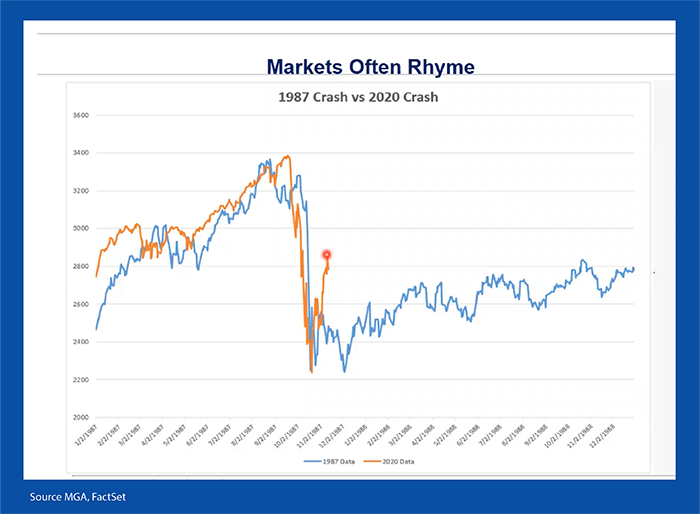
We are still trading in a technical market, meaning the market moves more on headlines than fundamentals. When we are in times like this, charts take over a lot of investment decisions, and as such they deserve our attention, albeit against my strong objection.
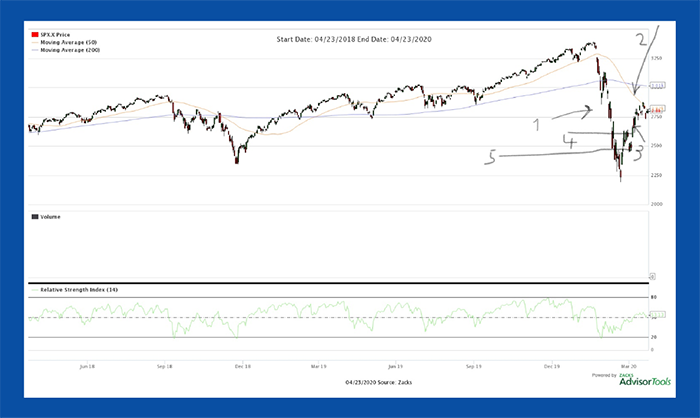
From my chart above there are 5 things I want to show you through that allows me to make some shorter-term predictions on the market. I believe that a short-term upwards breakout from here would have no basis to be sustained. I think we trade sideways from here while we eventually stabilize and get into recovery.
- That move down was too soon, too fast. Algorithms and computer trading exacerbated selling taking the market to massively oversold.
- The 50-day moving average is still pointing south and to get a sustained long-term bull run we would need to see it start to flatten and then move upwards.
- The move back up, has been too soon, too fast. Driven by monetary and fiscal response.
- 2600 which was our first pause on the way back from the low, now becomes our first support level.
- 2400, which was the low set in after the 2600 retracement becomes our second level of support.
I will give you some more color on all of this in the video version. Click here to watch.
To get back to looking at the market from a fundamental standpoint (meaning where we give more credibility to a companies earnings and business plans rather than how they’re trading), we will need the following 4 steps to be checked:
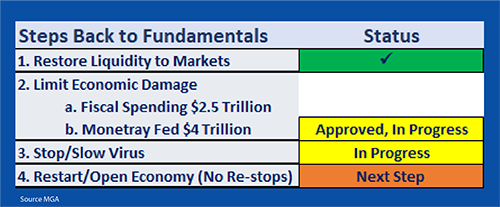
So now it’s the time to show you the buy/sell. Have a great week and as always shoud you have any questions or concerns feel free to give me a call.
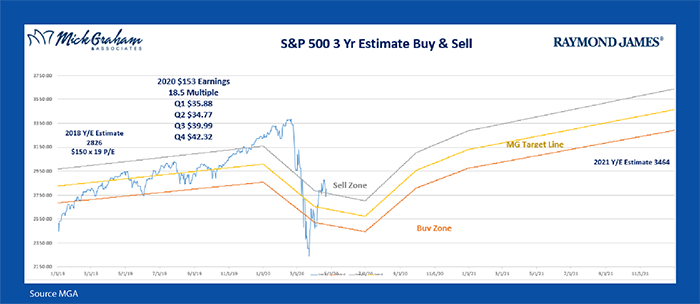
Any opinions are those of Mick Graham and not necessarily those of Raymond James. This information is not a complete summary or statement of all available data necessary for making an investment decision and does not constitute a recommendation. The information contained in this report does not purport to be a complete description of the securities, markets, or developments referred to in this material. Expressions of opinion are as of this date and are subject to change without notice. There is no guarantee that these statements, opinions or forecasts provided herein will prove to be correct. Investing involves risk and you may incur a profit or loss regardless of strategy selected. Keep in mind that individuals cannot invest directly in any index, and index performance does not include transaction costs or other fees, which will affect actual investment performance. Individual investor's results will vary. Past performance does not guarantee future results. Future investment performance cannot be guaranteed, investment yields will fluctuate with market conditions.
Investing in oil involves special risks, including the potential adverse effects of state and federal regulation and may not be suitable for all investors.
Investing in commodities is generally considered speculative because of the significant potential for investment loss. Their markets are likely to be volatile and there may be sharp price fluctuations even during periods when prices overall are rising. Futures trading is speculative, leveraged, and involves substantial risks.
The S&P 500 is an unmanaged index of 500 widely held stocks that is generally considered representative of the U.S. stock market.
Investing in the energy sector involves special risks, including the potential adverse effects of state and federal regulation and may not be suitable for all investors.

